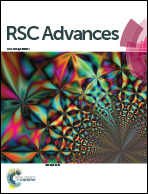Role of reactant concentration and identity of added cation in controlling emission from post-synthetically modified terbium incorporated zinc sulfide nanoparticles: an avenue for the detection of lead(ii) cations†
Abstract
This work reports the photophysical properties of 1-thioglycerol capped hydrophilic terbium cation incorporated (doped) zinc sulfide [Zn(Tb)S] nanoparticles, which have been post-synthetically modified using Pb2+ [Zn(Tb)S/Pb] under ambient conditions with [Zn(Tb)S] : [Pb2+] = 1 : 10−5–1 : 10, essentially providing a scenario with low to heavy co-doping and ultimately the possibility of forming a material of different chemical identity. The effects of selected concentrations of [Zn(Tb)S] : [Mn+] = 1 : 1 and 1 : 10−2 have also been evaluated for the post-synthetic addition of Hg2+, Cd2+, Ca2+, Mg2+, Na+ and K+. The broad zinc sulfide nanoparticle and sharp Tb3+ emission have different dependence on the relative reactant concentration, with cation identity playing a significant role. The underlying photophysical processes have been rationalized based on the interplay among the (i) cation exchange, (ii) modification of the structural properties of the nanoparticles without necessarily exchanging the cations and (iii) emission enhancement of terbium dopants. In cases where Tb3+ emission is apparent, all the nanoparticles studied demonstrate an optical antenna effect, thus accessing a lower Tb3+ concentration regime compared to in bulk environments. The results presented provide an avenue for the detection of heavy metal ions in general and Pb2+ in particular, with a limit of detection that is at least in the range of sub-ppm, using either the broad ZnS or sharp Tb3+ emission, respectively. This strategy provides an avenue to combine (i) the extremely sensitive and easily accessible analytical technique of photoluminescence spectroscopy, (ii) post-synthetic modification reactions in semiconductor nanoparticles that can be performed with less experimental demand, (iii) time-gated measurement related to the longer luminescence lifetime of terbium cations and (iv) the simultaneous use of broad ZnS nanoparticle and sharp Tb3+ emission from the same assembly, helping eliminate false positive results.



 Please wait while we load your content...
Please wait while we load your content...